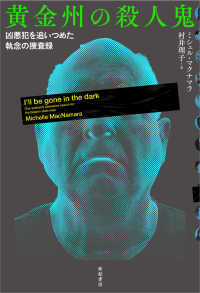- ホーム
- > 洋書
- > 英文書
- > Psychology
Full Description
Teaching Statistics and Quantitative Methods in the 21st Century is a guide for rethinking and revitalising statistics and quantitative methods pedagogy for both novice and experienced instructors at undergraduate and graduate levels. It offers modern, transformative approaches to preparing students as future researchers.
Now in its second edition, this ground-breaking volume tackles the question of how introductory statistics and quantitative methods should be taught, drawing on contributions from highly accomplished teachers. Many current textbooks and syllabi remain little changed from those used half a century ago, despite major developments in the field and its role in research. The book rests on a core principle: introductory teaching should open the pathway to advanced training and equip students to become accomplished researchers.
New chapters address:
The role of Artificial Intelligence in teaching statistics
Classroom software applications and applets
Automated homework generation and grading
Teaching the replication crisis
New treatments of p-values, null hypothesis significance testing, and abduction
A pedagogical approach based on statistical modelling rather than hypothesis testing
Updated and expanded chapters from the first edition sit alongside these new contributions, presenting both classroom innovations and philosophical challenges to the status quo. The result is a call for a broad reimagining of how statistics and quantitative methods are introduced, designed to engage students, support new instructors, and renew the practice of seasoned teachers
Contents
List of contributors
Preface - Camilla Benbow
Foreword - Lisa Harlow
1. Teaching Statistics and Quantitative Methods: An Introduction to 15 Chapters, Some Old and Some New, on Statistical Pedagogy and Philosophy - Joseph Lee Rodgers
Section I: Meta-Issues Related to Teaching: Philosophical Considerations
2. Including Philosophy of Science when Teaching Statistics - Michael C. Edwards
3. Teaching Statistics for Knowledge Generation and Principled Argument -- Jolynn Pek, Duane T. Wegener, and Kalina J. Dusenbery
4. When Statistical Assumptions Are Interesting Outcomes Instead of Nuisances - Looking Beyond the Mean - Rachel T. Fouladi
5. Introductory Statistical Pedagogy Should Be Reformed: Transitioning from a Hypothesis Testing to Modeling Framework -- Dustin A. Fife, Thomas W. O'Kane, Joseph Lee Rodgers
6. Teaching Introductory Statistics to Applied Researchers in the 21st Century: A Dialectic Examination - Joseph Lee Rodgers
Section II: Modern Classroom Innovations in Teaching Statistics and Quantitative Methods
7. Artificial Intelligence, COVID-19, and Ways of Knowing: Teaching Introductory Statistics as an Asynchronous Online Course in 2025 - Matthew S. Fritz
8. The Quantitative Methods Homework Unicorn: Providing Scalable Yet Individual Feedback on Analysis Results and Interpretation -- Lesa Hoffman, Jonathan Templin, and David DeWester
9. Teaching Statistics Using Web Applets -- Charles S. Reichardt
10. The Eyes Have It: Emphasizing Data Visualization when Teaching Students Meeting a Quantitative Literacy Requirement - Robert Terry. Vicent T. Ybarra
11. Low- and Medium-Tech Complements to High-Tech Tools for Teaching Statistics: The Case for Using Appropriate Technology to Implement Cognitive Principles for Teaching -- David Rindskopf
12. Flipping the Quantitative Classroom for Individualized, Active Learning - Pascal R. Deboeck
13. Selecting Statistical Software for Teaching and Learning -- Christian L. L. Strauss, R. Shane Hutton, Alexandria Ree Hadd
14. Using Projects to Teach Statistics in Social Sciences -- Jennifer D. Timmer, Carolyn J. Anderson
15. Teaching Statistics with a BYOD (Bring Your Own Device) Student Response System --
R. Shane Hutton, Christian L.L. Strauss, and Derek Bruff
16. Can the Replication Crisis Inform our Teaching of Introductory Statistics? -- Patrick E. Shrout, Joseph Lee Rodgers







